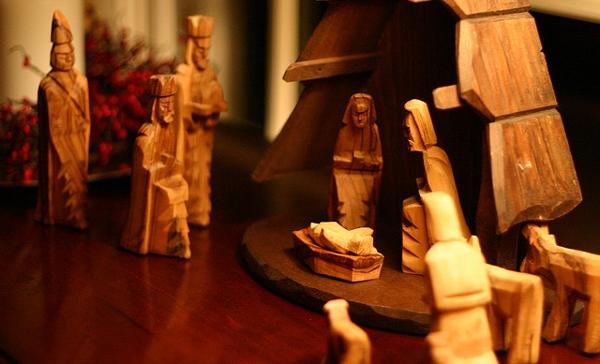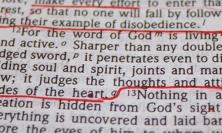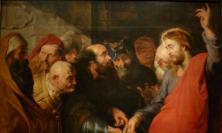Matthew’s account of the birth of Jesus might be the first one we read in the New Testament, but it was not the first to have been written. Peter Edmonds SJ thinks about how the gospel’s opening verses were shaped by earlier references to Jesus’s birth and by the books of the Old Testament.
Anybody wanting to read the earliest account of the Christmas story could be forgiven for thinking that the beginning of the New Testament would be the best place to start. But there is a problem. Matthew’s Gospel is placed at the beginning of the New Testament, not because it was the first of the New Testament’s books to be written, but because it is the gospel in which we find the most elevated portrait of Jesus, the fullest exposition of his teaching and the only references to the Church in all the gospels. Expert opinion informs us that all the gospels date from a time after the major epistles of Paul were composed, and also that Matthew’s was not the first New Testament gospel to take shape. This honour belongs to Mark. Matthew’s ‘Christmas story’ represents a report that dates from the third generation of Christianity – that is, around the mid-eighties of the first century, many years after the events it describes – and was no doubt shaped by earlier texts. So in order to understand what Matthew is trying to tell us in the opening chapters of the New Testament, we would do well to think about the beginning of his gospel in the context of what we read elsewhere in the bible.
Paul and the Acts of the Apostles
In the letters of Paul, the earliest New Testament writings, there is a single reference to the birth of Jesus Christ. This comes in the Letter to the Galatians, as part of a series of theological arguments that Paul employs to support his message: ‘when the fullness of time had come, God sent his Son, born of a woman, born under the law, in order to redeem those who were under the law, so that we might obtain adoption as children’ (Galatians 4:4-5). This lone mention of the birth of Christ contrasts with Paul’s repeated emphasis on the significance of Christ’s death and resurrection.
We read the fullest reference to these events towards the end of the First Letter to the Corinthians where Paul writes, ‘For I handed on to you as of first importance what I in turn had received: that Christ died for our sins in accordance with the scriptures, and that he was buried, and that he was raised on the third day in accordance with the scriptures, and that he appeared to Cephas, then to the twelve’ (1 Corinthians 15:3-5). Paul is appealing to the gospel message which he had preached on previous occasions to the Corinthians and to what he himself had been taught, presumably after his conversion which is dated around AD 36. This text brings us back to the first days of Christianity.
This emphasis on the death and resurrection of Christ is also found in the speeches of Peter reported in the Acts of the Apostles, which stress these events as the centre of the Christian message. In his speech on Pentecost day, Peter says, ‘God has made him both Lord and Messiah, this Jesus whom you crucified’ (Acts 2:36). Before the High Priest and his Council, Peter says, ‘The God of our ancestors raised up Jesus, whom you had killed by hanging him on a tree’ (Acts 5:30). Peter says nothing about the Christmas story. Its proclamation is being reserved for a later stage of the Christian mission.
The Gospel of Mark
When in due course the first written gospel appeared – that of Mark, usually dated AD 65-70, a decade or so after the undisputed letters of St Paul – we look in vain for any report of the infancy and birth of Jesus. Mark begins with a quotation of three Old Testament passages which refer to the exodus of God’s people from Egypt (Exodus 23:20), their exile in Babylon (Isaiah 40:3) and their return from exile (Malachi 3:1). Mark is telling us how, in Jesus, God continues his past activity on behalf of his people. The evangelist, after introducing John the Baptist and reporting his preaching activity, then brings the adult Jesus onto his stage, as a man who comes from Nazareth to be baptised by John. At his baptism a voice from heaven pronounces Jesus as his Son; Jesus is then driven into the wilderness by the Holy Spirit and tested by Satan. There, ‘he was with the wild beasts and the angels waited on him’. Then he began his ministry. He announced, ‘The time is fulfilled and the kingdom of God has come near; repent, and believe in the good news.’ (Mark 1:1-15)
The Gospel of Matthew
We can surmise that the gospel attributed to Mark became known and valued in places other than its initial destination, which may have been Rome in the time of the Emperor Nero or Syria in the tense years before the Jewish revolt of AD 70. It reflected the needs and interests of a persecuted community and was less obviously relevant to those for whom Matthew is reckoned to be writing, who may well have been a group of former members of a synagogue in the cosmopolitan city of Antioch, a group struggling to establish its identity as God’s special people after expulsion from their community. So, the person whom we know as Matthew rewrote Mark’s Gospel in ways more appropriate for that community’s need – in worship, the instruction of their converts and defence against their critics. He does this as a ‘scribe who has been trained for the kingdom of heaven . . . who brings out of his treasure what is new and what is old’ (Matthew 13:52).
In this new gospel account, the main points of Mark’s beginning are not only kept but expanded. Matthew tells us more about John the Baptist, and about the baptism of Jesus and his testing by Satan in the wilderness (Matthew 3:1-4:12). But before this, Matthew inserts four sections about the origin and background of Jesus. We learn about Jesus’s ancestry (1:1-17). We learn about his birth and how he came to be born (1:18-25). We learn about his reception by foreigners and his rejection by the leaders of his own people (2:1-12). We learn about the drama of his early years, how he escaped death, went into exile in Egypt and how finally he came to be in Nazareth (2:13-23).
The Generations (Matthew 1:1-17)
The first section is a genealogical table. It is introduced by an announcement that Jesus is Son of David and Son of Abraham. There may well be two Old Testament passages implied by these two titles. The first is God’s promise to King David through the prophet Nathan that God ‘would establish the throne of his kingdom for ever’ (2 Samuel 7:13). The second is the promise that God makes to Abraham that, ‘in you all the families of the earth shall be blessed’ (Genesis 12:3). This beginning suggests that the community of Matthew was a mixed one of Jew and Gentile – Jesus belonged to both.
There follows a list of the ancestors of Jesus. At first sight, this is the sort of list that we find in various places in the Old Testament. We read about the ancestors of Abraham in Genesis (11:10-32) and of David in the book of Ruth (4:18-22). We might think that such a list has little to tell us, but it repays careful reading. It gives us an insight into how God works in unexpected and surprising ways. Among the royal ancestors of Jesus are bad kings as well as good kings. Some are known to us from the Old Testament, others are quite unknown. Some are first-born in the family but others are junior siblings. There are only five women in the list, but their stories are well worth exploring. Moreover, the list falls neatly into three groups of fourteen, and fourteen is the sum of the letters in Hebrew that make up David’s name.
Somehow God overcomes many obstacles to bring about the birth of Jesus. This is surely a God of mystery. It is this God who speaks from heaven and proclaims Jesus as his beloved Son (Matthew 3:17). He is the God whom Jesus will later acknowledge as his Father, ‘Lord of heaven and earth’ (11:25).
Joseph (Matthew 1:18-25)
If the genealogy instructs us as to who Jesus is, the next section informs us how he came to be born. Again, this is a mysterious birth, because Jesus did not have a human father; as the angel informed Joseph when Mary was found to be with child, ‘the child conceived in her is from the Holy Spirit’. We first meet this creative Holy Spirit in the second verse of the bible where we learn that ‘the spirit of God swept over the face of the waters’ (Genesis 1:2), and we frequently encounter this Spirit in the prophets. Ezekiel, for example, looks forward to the time when God would put a new Spirit within his people as an agent of renewal (Ezekiel 36:26).
Matthew concludes this paragraph with the ‘Emmanuel’ quotation from Isaiah (7:14). This child would be ‘God with us’, which prepares us for the promise of the Risen Christ at the end of the gospel that he would be with his disciples, ‘always, to the end of the age’ (28:20). His name would be Jesus, because ‘he would save his people from their sins’. Readers familiar with the stories of the birth of Ishmael, son of Hagar, and of Isaac, son of Sarah (Genesis 16-18), and of Samson (Judges 13), will enjoy recognising how the annunciation by the angel to Joseph follows a similar pattern to these ancient traditions. Here is a typical Matthew text replete with doctrinal material for the catechist eager to explain the significance of this Christ.
The Wise Men (Matthew 2:1-12)
Matthew’s third section is perhaps more familiar to us from its use on the Feast of the Epiphany rather than at Christmas. It combines a search for the ‘king of the Jews’ by wise men ‘from the East’, their joy at their arrival ‘at the house’ and their worship of the child. All this is in contrast to the lack of interest of the ‘chief priests and the scribes’ who, despite their learning and knowledge of the scriptures, took no action. The reader knows that Herod, despite his smooth words, has no intention of meeting and paying homage to a rival king.
We can easily read this paragraph as an anticipation of the Passion story. There are parallels to be drawn. The inscription on the cross on which Jesus died reads, ‘King of the Jews’ (Matthew 27:37). Herod called for a secret meeting with the wise men (2:7); the chief priests ‘conspired’ to arrest Jesus (26:4). There are contrasts, too. The light of a star brought the wise men to Jesus, but on Calvary there would be darkness. The wise men worshipped Jesus (2:2,11); on Calvary, the leaders of his own people mocked him (27:41-43), yet the Gentile centurion and his companions confessed him to be ‘God’s Son’ (27:54). As in the previous paragraph, Matthew includes words from scripture, combining quotations from Micah (5:2-3) about his birthplace in Bethlehem and 2 Samuel (5:2) about his role as shepherd. Both of these texts link Jesus with King David of old.
Egypt and Nazareth (Matthew 2:13-23)
The fourth and concluding section of Matthew’s infancy story falls into three parts. In the first (2:13-15), Joseph takes the child Jesus and his mother to Egypt. The attentive reader remembers how another Joseph who dreamed also went down to Egypt (Genesis 39:1). The prophet Hosea provided a convenient text about God calling his son out of Egypt (11:1).
In the second part (2:16-18), Herod attempts to kill the child whom the wise men had worshipped. In a narrative that resembles the plotting of the Pharaoh to kill the infant Moses (Exodus 1:16), Herod fails. A quotation from the prophet Jeremiah reassures us that all this was known to God (Jeremiah 31:15). If Matthew presumes that his reader is familiar with the rest of this chapter of Jeremiah, he wants us to share the optimism and hope that marks this chapter as a whole. For God, the massacre of the holy innocents was not the end of the story.
In the third part (2:19-23), we arrive at Nazareth, the village from which, according to Mark, Jesus set out to seek John the Baptist (Mark 1:9). Once more, Joseph whom we have met already as a ‘righteous man’ (1:19), is obedient to the voice of an angel. He takes the child and his mother and brings them not to the land of Israel, but to Galilee, in the north where Archelaus, a nasty son of Herod, had no jurisdiction. This was where the public ministry of Jesus would begin. It would be the place where the people of Isaiah’s prophecy, ‘who sat in darkness’, would see a great light (4:16). As for Jesus himself, he would be called a Nazarene. Like Samson in the Book of Judges, he would be a Nazarite consecrated to God (Judges 16:17).
At this point, Matthew resumes his story along lines parallel to Mark, with his expanded versions of the mission of John the Baptist, the baptism of Jesus and the temptations that followed. His readers are now ready to listen to his account of the mission of Jesus. They have been admitted to Matthew’s theological workshop in which they have learnt about a God who is living and true, about a Jesus who saves his people from their sins and who is Emmanuel, ‘God with us’, about Joseph who has proved himself righteous in applying the law of God and obedient to the mission given to him.
Matthew’s Gospel is proclaimed on most Sundays in Year A of the three-year lectionary cycle. May these four paragraphs of Matthew’s ‘infancy narrative’ prove a sound foundation for us to hear the message of this gospel and understand it, so that, in the words of Jesus concluding his parable teaching, we may bear fruit, some a hundredfold, some sixtyfold, others thirtyfold (Matthew 13:23).
Peter Edmonds SJ is a member of the Mount Street Jesuit Community.






